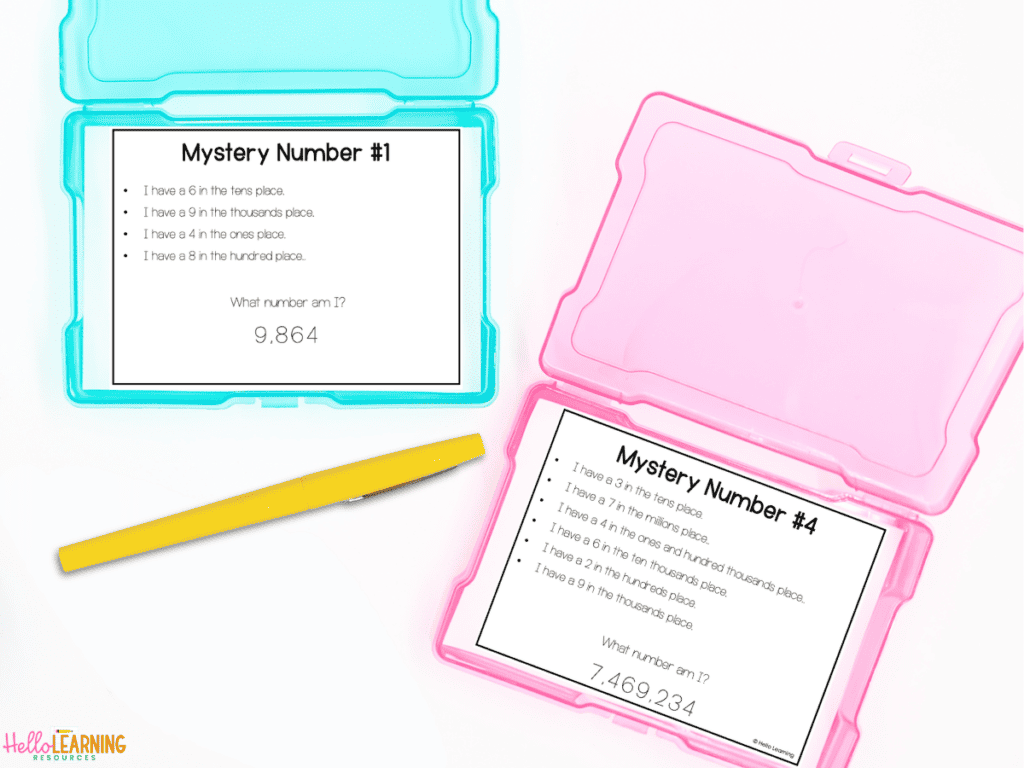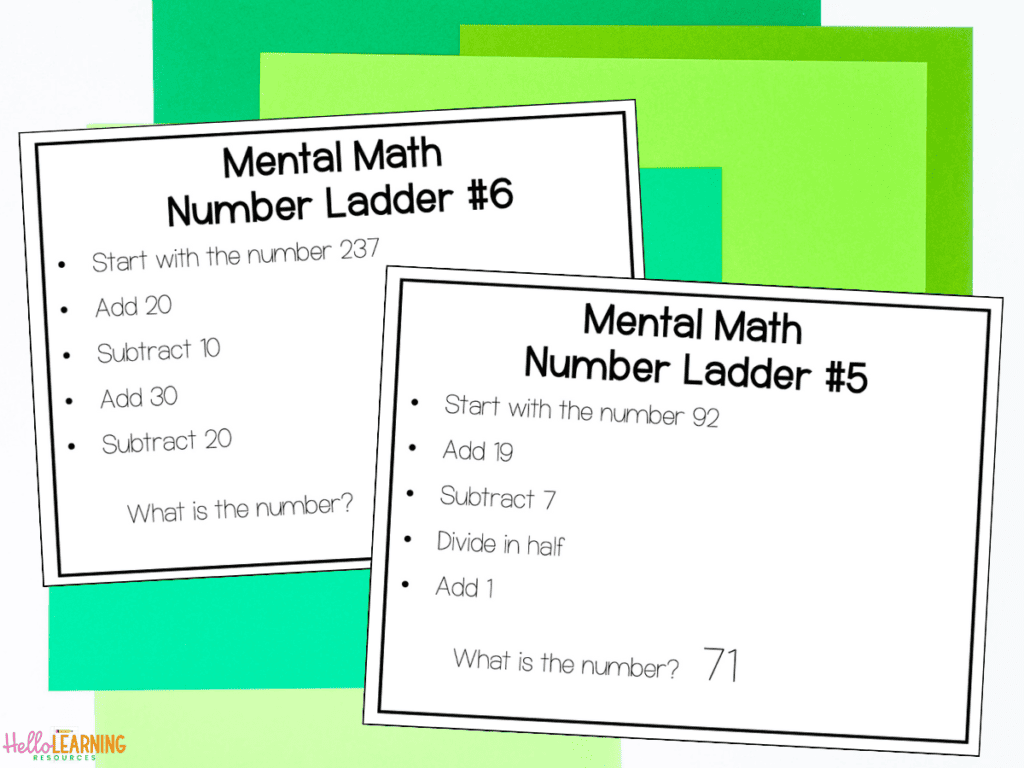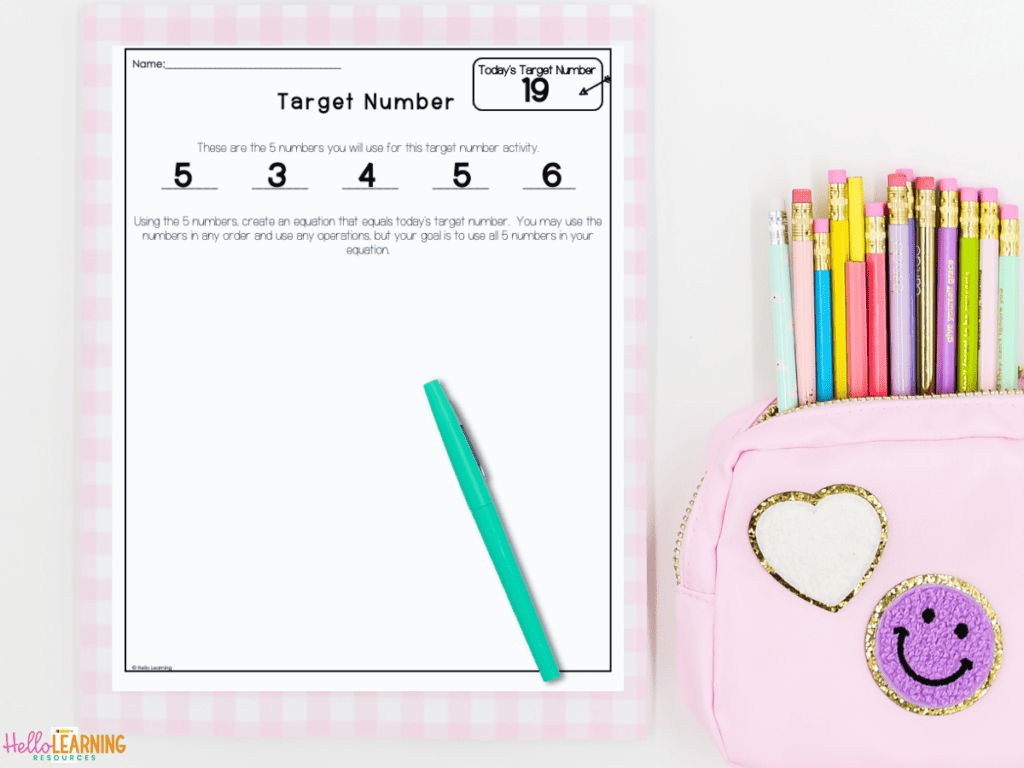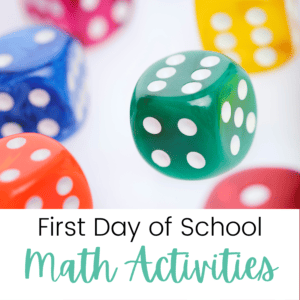10 Fun Math Warm-Up Activities
Are you looking for fun math warm-up activities that you can use to start your math class each day? Math warm ups are a great way to grab students interest at the beginning of math class and get them thinking about math.
These math warm-up activities only take 5-10 minutes at the beginning of your math class but are packed with a lot of valuable math content. You will love how easy they are to plan and implement, and your students will love how fun and engaging they are.
Math Puzzles
Math picture puzzles are great math warm-up activities that help build algebraic thinking, problem-solving, creative thinking, flexibility with numbers, and concentration. You can find math equation puzzles like the one shown below HERE!
Math puzzles can be done as a whole class by projecting the puzzle on a screen, or they can be done independently by printing copies for each student.
Math puzzles come in many formats like picture equation puzzles, secret number puzzles, math logic puzzles, balance the scale, multiplication grids, color logic, and more!
My math logic puzzle and brainteaser packs include a wide variety of puzzles for different themes, seasons and holidays. You can find math puzzles like the ones shown below HERE.
Solving math puzzles like these grab students’ attention and give them a low risk opportunity to practice applying different math and critical thinking skills, while also motivating them to work on challenging problems until they find a solution.
Grab a FREE set of 10 math puzzles by CLICKING HERE.
Number Talks
Number talks are great for highlighting math strategies, building flexibility with numbers, and communicating about math. They only take 5-10 minutes but can have a huge impact on students’ understanding of different math strategies and concepts.
Number talks can come in many formats like number strings, which one doesn’t belong, what do you notice, word problems, patterns, balance scales, or images to analyze.
With number talks, you can choose to highlight a specific strategy or you can let the students’ discussion lead which strategies you talk about and highlight.
You can grab my FREE set of 20 days of number talks and number strings HERE.
You can read more about number talks and number strings HERE or HERE.
Get the Ultimate Guide to Number Talks HERE.
If you are looking for ready-to-go number talks perfect for upper elementary, CLICK HERE.
Choral Counting or Counting Circles
Using choral counting or counting circles as a math warm-up builds number sense and helps students see patterns in numbers.
All you need is a starting number and a count by number.
For example, you may say “Starting with 7, count up by 5s.” or “Starting with 74, count down by 3s.”.
With choral counting, the whole class counts/says the numbers together. It is great if the teacher can write down the numbers as the class counts them so students can see patterns that emerge in numbers visually.
With counting circles you have students stand in a circle and you go around the circle having students individually continue the counting pattern you have selected.
This math warm-up can be differentiated by using larger numbers, decimals, or fractions.
Problem of the Day
Project an equation or word problem for your students to solve as a math warm-up. I like to choose a problem that relates to the skill we are currently working on or a skill we have recently completed. This is a quick and easy way to get kids thinking about math right away and allows kids to share a variety of strategies and possible solutions.
I love using task cards for this math warm-up. If you have a set of 20-30 task cards, you can pick one of the cards to use each day as your math warm-up.
One set of task cards could provide you with a whole month of problem of the day math warm-up activities!
Number of the Day
Number of the day is a very versatile math warm-up that is easy to plan, implement and differentiate!
Pick a number you want to work with each day. Then, students apply a bunch of math skills or operations to that number. For example, if your number of the day is 37, you may have students add 10, subtract 10, multiply by 10, and divide by 10. You could have them identify if it is even or odd, and whether it is a prime or composite number.
Number of the day warm-ups can be done as a whole class, projecting a number of the day template and filling it in together, or you can have students complete it individually and go over the answers together. You could even use it as a mini check-in to see how students are doing with certain concepts.
You can easily differentiate this activity by adjusting the numbers to be larger, smaller, decimals, or even fractions.
You can create your own number of the day templates, or you can grab one that is perfect for upper elementary in my FREE math warm-up activity pack by CLICKING HERE.
Mental Math Warm Up Activities
Mental math activities help strengthen math fact recall and the ability to quickly solve simple math problems. It also builds student strategies for efficiently solving computation problems.
I like to do mental math as a math warm-up or as a math time filler when I have an extra 5-10 minutes open during the day.
One of my favorite ways to do this activity is by giving students a starting number and then dictating several math operations to perform on that number.
For example, you might say, “Start with 13. Add 15. Subtract 7. Add 20. What is the result?”.
Students then share what number they ended up with.
Number ladders are similar to oral mental math activities, except they are done on paper.
Students have a starting number and they work their way up the ladder performing the different math operations for each ladder rung until they get to the top of the ladder.
This math warm-up can be differentiated by using different starting numbers.
You can grab some free mental math cards as part of my math warm-up packet HERE.
Students can complete each rung of the ladder mentally or you can give them the option of working out each step on their paper.
Grab this number ladder sheet and a blank template HERE.
Equations
Give students a number and challenge them to make an equation that equals that number. For example, you might give them the number 85, and challenge them to come up with as many equations as possible that equal 85.
To increase the difficulty of this warm up, give students one or more parameters that they must include in their equation. For example, you might give them the number 70, and require that their equations include 3 or more numbers, only use division, use two operations, or include at least one odd number.
Creating equations is an easy activity that allows a point of entry for all students to participate while also offering students to challenge themselves.
Target Number Math Warm Up
In the target number math warm-up, students try to use all five pre-selected digits to make an equation that equals the selected target number.
I like to have my students choose a target number for us to work with. You can narrow their options by giving them a range to choose from. (Pick a target number between 30 and 75).
Then, we roll a die five times to generate five numbers to work with to build an equation.
While the goal is to use all 5 numbers to make an equation that equals the target number, I always praise students’ successes in making an equation using less than 5 of the digits. Then, I encourage them to keep playing with the numbers to see if they can find a way to use all 5.
Some combinations are more challenging to solve than others. If we do not find a solution I either post it as an ongoing challenge that kids can keep working on if they finish other activities early or challenge kids to bring it home and see if they can find a solution with the help of their family.
To add more of a challenge, you can use dice with more numbers or larger numbers to generate the digits students can use to make their target number equation.
Number Riddles or Mystery Number

The mystery number math warm-up is great for reinforcing place value concepts with whole numbers and decimals.
You give clues, telling students what place value position a given digit is in and students build the number.
For example, you might say “There is a 3 in the ones place. There is a 4 in the thousands place. There is a 5 in the tens place. There is a 2 in the hundreds place. What is the number?”
Students share their final number after all of the clues have been given. You can increase the difficulty by using larger numbers, decimal numbers, or more challenging clues (ex: the digit in the tens place is double the digit in the ones place).
Grab a free set of mystery number cards HERE.
What’s the Question?
In this math warm-up activity, you give students a solution (ex: 24, 32 square inches, 7 feet, 5 hours) and they have to come up with a problem to match the solution.
You can leave the problem type open-ended or specify that you want them to create a word problem.
I love the creativity of the problems students come up with and the variety of the types of questions they create for each solution. It really helps kids connect math to many different situations.
There you have it! 10 fun math warm-up activities that are easy to use, easy to plan, fun for kids, and full of learning!
If you would like to try some of these activities with your class, I have put together a FREE math warm-up activity pack that includes:
- Number of the Day
- Target Number
- Mental Math
- Math Ladders
- Mystery Numbers
CLICK HERE to grab your FREE math warm-ups resource!

















